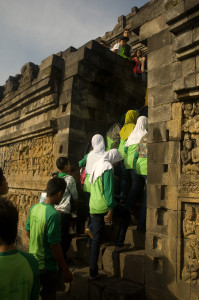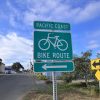By: Labodalih Sembiring
An early morning in February, a group of men and women from all over the world arrived at the foot of Borobudur, a candi or ancient temple in a sub-district of the same name in Magelang, Central Java. Led by Lama Gangchen Rinpoche from western Tibet, they circumnavigated the six platforms all the way up starting from the eastern stairway. This is how pilgrims usually perform worship at this largest Buddhist monument in the world.
It was early morning. The group of pilgrims, peacefully worshipped the relief panels, stupas and Buddha statues, as well as the breathtaking view as the sun slowly rose from behind the hills of the Kedu Plain, a land also known as the “garden of Java.”
The beautiful vistas all around this temple are enhanced by the presence of Merapi and Merbabu volcanoes in the east and Sindoro and Sumbing volcanoes in the north. Rivers, big and small, crisscross the fertile area; two of them, Elo and Progo, are famous among local rafters.
A bit of History
It is estimated that Borobudur took 75 years to build, at the peak of the Syailendra dynasty in the 9th century. It consists of ten platforms — six of square shape, three round, and one main stupa at the center of top platform. Indeed, the temple’s original name as proposed by Dutch philologist J.G. de Casparis, is Bhumi Sambhara Budhara, Sanskrit for “the mountain of combined virtues of the ten stages of Boddhisattvahood.”
The lowest platform represents the Kamadhatu, or the world of desire, in Buddhist cosmology. The next four platforms symbolize the four stages of the Rupadhatu or the world of forms, while the last three platforms signify the Arupadhatu, the formless world, suggested by the absence of reliefs. The stupas on the highest platforms are perforated, unlike the biggest stupa that crowns the monument.
For over four hundred years since the 14th century, the temple was abandoned following the decline of Buddhist and Hindu kingdoms as well as the spread of Islam in Java. The intended purpose of its construction is still not clear. However, its major renovation between 1975 and 1982 has allowed thousands to flock the temple every year, during the full moon in May, to commemorate Waisak, or the day of the birth, enlightenment and death of Prince Siddharta or Buddha Gautama.
How to get there
Borobudur is sometimes mistaken to be located in Yogyakarta, a neighboring province on the south. It is understandable as the nearest international airport is located there, and the province is indeed dotted by many temples, such as the Prambanan. It takes around an hour from Yogyakarta City to Borobudur by motored vehicles.
Many buses at the Jombor Bus Terminal — about 10 kilometers from the airport to the west — carry passengers to the Pal Bapang T-section through the Yogyakarta-Magelang Road for Rp 10,000-15,000. From Pal Bapang to the Borobudur Bus Terminal, one can take another bus for Rp 3,000-4,000. Passing by the border gate between Yogyakarta and Central Java, one will not miss seeing the stone handicrafts for sale lining both sides of the road. Those driving a car might want to take the more scenic route from Godean on the west side of Yogyakarta to the north. Car rentals are available all around Yogyakarta, price starting from Rp 300,000 per day.
Around Borobudur
Finding a place to stay is not difficult for those planning to stay around the temple. Various hotels for different budgets are available, the closest being Manohara, Amanjiwo, Rajasa, Saraswati Borobudur, and Lotus Guest House. Those interested in learning about life in the surrounding villages can stay at the locals’ humble homes, where there are rooms offered for low prices, such as in the village of Candirejo.
Once in Borobudur, do not pass the opportunity to visit the nearby Mendut and Pawon temples, the Borobudur traditional market, as well as the Sasana Gunarasa puppet museum. Talk to locals to locate charming springs in the area, and check for schedules if you are interested in meditating in the Mendut Buddhist Monastery or watching art performances at Pondok Tingal.
Notes: The entrance fee to Borobudur Temple Complex ranges from Rp12,500 to Rp17,500 per person — depending on the day — for adult locals, and $15 per person for foreign tourists. For children and elementary or high school students in a group of at least 20 people, the price is Rp10,000-11,000 (local) and $8 (foreign) per person. The price is much higher during peak seasons (Ied, Christmas, New Year holidays). One ticket covers the entrance permit to the temple, the Samudra Raksa Museum, and the Karmawibangga Museum, as well as a screening of a documentary about the history of Borobudur and the permit to bring a camera or video camera. The temple opens from 6 a.m. until 5 p.m. every day, but many hotels and travel agents in Yogyakarta and Central Java offer a Borobudur sunrise tour package.













